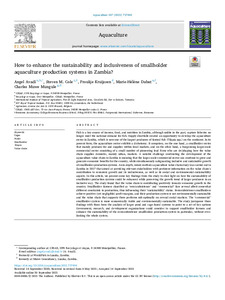| dc.contributor.author | Avadí, A. |
| dc.contributor.author | Cole, S.M. |
| dc.contributor.author | Kruijssen, F. |
| dc.contributor.author | Dabat, M. |
| dc.contributor.author | Mungule, C. |
| dc.date.accessioned | 2022-02-03T15:22:28Z |
| dc.date.available | 2022-02-03T15:22:28Z |
| dc.date.issued | 2022-01-30 |
| dc.identifier.citation | Avadí, A., Cole, S.M., Kruijssen, F., Dabat, M. & Mungule, C. (2022). How to enhance the sustainability and inclusiveness of smallholder aquaculture production systems in Zambia?. Aquaculture, 547: 737494, 1-14. |
| dc.identifier.issn | 0044-8486 |
| dc.identifier.uri | https://hdl.handle.net/20.500.12478/7348 |
| dc.description.abstract | Fish is a key source of income, food, and nutrition in Zambia, although unlike in the past, capture fisheries no longer meet the national demand for fish. Supply shortfalls created an opportunity to develop the aquaculture sector in Zambia, which is now one of the largest producers of farmed fish (Tilapia spp.) on the continent. In its present form, the aquaculture sector exhibits a dichotomy. It comprises, on the one hand, a smallholder sector that mainly produces for and supplies within local markets, and on the other hand, a burgeoning larger-scale commercial sector consisting of a small number of pioneering lead firms who are (re)shaping how the value chain supplies domestic, mainly urban, markets. A notable challenge confronting the development of the aquaculture value chain in Zambia is ensuring that the larger-scale commercial sector can continue to grow and generate economic benefits for the country, while simultaneously safeguarding inclusive and sustainable growth of smallholder production systems. An in-depth, mixed-methods aquaculture value chain study was carried out in Zambia in 2017 that aimed at providing relevant stakeholders with pertinent information on the value chain's contribution to economic growth and its inclusiveness, as well as its social and environmental sustainability aspects. In this article, we present some key findings from the study to shed light on how the sustainability of smallholder production systems could be enhanced while preserving the growth trend of larger producers in an inclusive way. The study found that the value chain is contributing positively towards economic growth in the country. Smallholder farmers classified as “semi-subsistence” and “commercial” face several albeit somewhat different constraints to production, thus influencing their “sustainability” status. Semi-subsistence smallholders achieve positive (yet negligible) profit margins, and their production system is not environmentally sustainable and the value chain that supports them performs sub-optimally on several social markers. The “commercial” smallholder system is more economically viable and environmentally sustainable. The study juxtaposes these findings with those from the analysis of larger pond and cage-based systems to point to a set of key options Government, research, and development organisations could consider to support smallholder farmers and enhance the sustainability of the semi-subsistence smallholder production system in particular, without overlooking the whole system. |
| dc.format.extent | 1-14 |
| dc.language.iso | en |
| dc.subject | Cages |
| dc.subject | Ponds |
| dc.subject | Smallholders |
| dc.subject | Tilapia |
| dc.subject | Value Chains |
| dc.subject | Aquaculture Development |
| dc.subject | Fish |
| dc.title | How to enhance the sustainability and inclusiveness of smallholder aquaculture production systems in Zambia? |
| dc.type | Journal Article |
| cg.contributor.affiliation | Centre de Coopération Internationale en Recherche Agronomique pour le Développement |
| cg.contributor.affiliation | Université de Montpellier |
| cg.contributor.affiliation | International Institute of Tropical Agriculture |
| cg.contributor.affiliation | KIT Royal Tropical Institute |
| cg.contributor.affiliation | Agrinatura, Belgium |
| cg.contributor.affiliation | Botswana Accountancy College/Botswana Bussiness School |
| cg.coverage.region | Africa |
| cg.coverage.region | Southern Africa |
| cg.coverage.country | Zambia |
| cg.coverage.hub | Eastern Africa Hub |
| cg.researchtheme | Social Science and Agribusiness |
| cg.identifier.bibtexciteid | AVADI:2022 |
| cg.isijournal | ISI Journal |
| cg.authorship.types | CGIAR and developing country institute |
| cg.iitasubject | Agribusiness |
| cg.iitasubject | Food Systems |
| cg.iitasubject | Nutrition |
| cg.iitasubject | Smallholder Farmers |
| cg.iitasubject | Socioeconomy |
| cg.iitasubject | Value Chains |
| cg.journal | Acquaculture |
| cg.notes | Open Access Article; Published online: 29 Sep 2021 |
| cg.accessibilitystatus | Open Access |
| cg.reviewstatus | Peer Review |
| cg.usagerightslicense | Creative Commons Attribution 4.0 (CC BY 0.0) |
| cg.targetaudience | Scientists |
| cg.identifier.doi | https://dx.doi.org/10.1016/j.aquaculture.2021.737494 |
| cg.futureupdate.required | No |
| cg.identifier.issue | 737494 |
| cg.identifier.volume | 547 |

